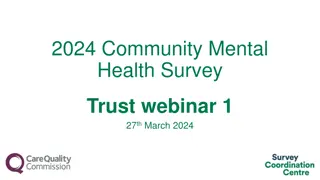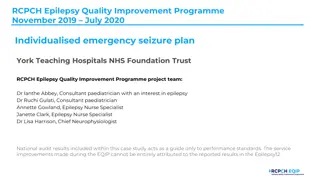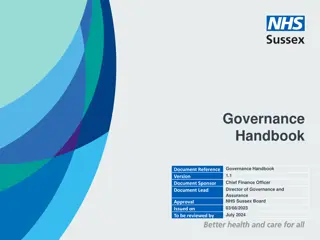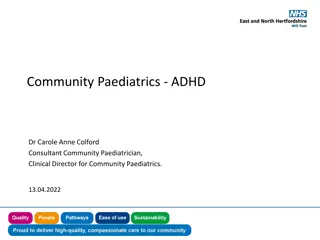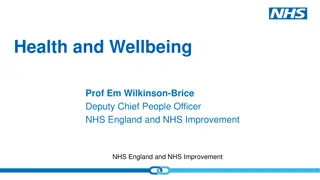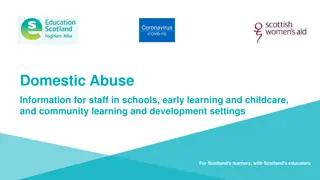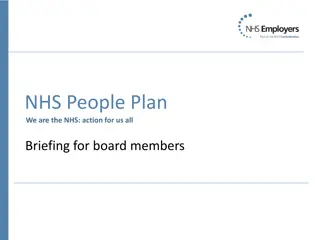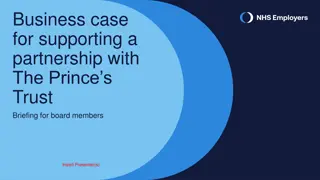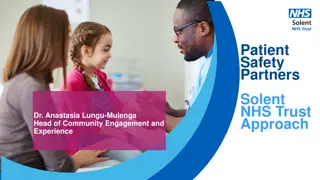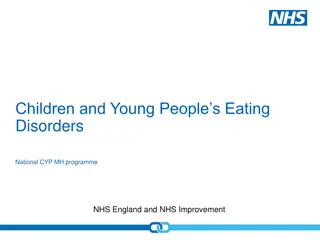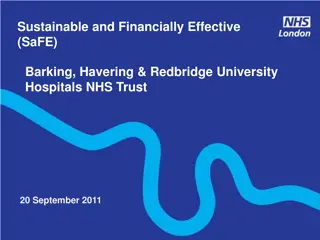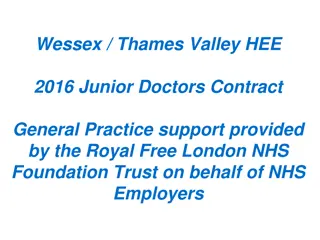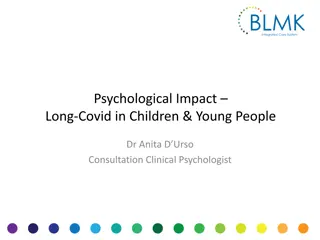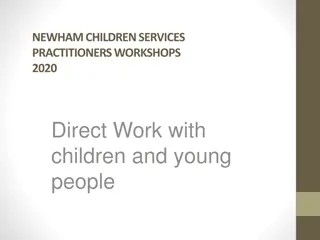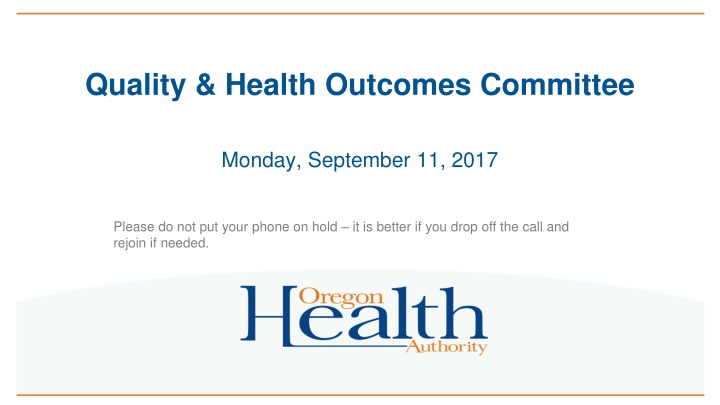
Overview of Children and Young People's Survey 2024 NHS Trust
This document provides insights into the Children and Young People's Survey 2024, including its purpose, topics covered, who completes the survey, key dates, and redevelopment roadmap. The survey is crucial for improving healthcare quality for children and young people and is used by various stakeholders for assessments and regulatory activities.
Download Presentation

Please find below an Image/Link to download the presentation.
The content on the website is provided AS IS for your information and personal use only. It may not be sold, licensed, or shared on other websites without obtaining consent from the author. If you encounter any issues during the download, it is possible that the publisher has removed the file from their server.
You are allowed to download the files provided on this website for personal or commercial use, subject to the condition that they are used lawfully. All files are the property of their respective owners.
The content on the website is provided AS IS for your information and personal use only. It may not be sold, licensed, or shared on other websites without obtaining consent from the author.
E N D
Presentation Transcript
Quality & Health Outcomes Committee Monday, September 11, 2017 Please do not put your phone on hold it is better if you drop off the call and rejoin if needed.
Welcome and Introductions Follow from your packet on pages 1 - 12
Opportunities for health care and public health collaborations Safina Koreishi, MD MPH September 11, 2017
Opportunities for partnership CCOs Public Health Communicable disease control Physical health Environmental health CHA/ CHIPs Behavioral health Assessment and epidemiology Health equity Case management Oral health Case management Policy & planning Prevention & health promotion Access to clinical preventive services
Collaboration Shared meeting with 3 PH directors and CCO leadership Discussed shared priorities Used ease and impact scale to determine focus areas
PH Modernization Follow from your packet on pages 13 19
Collaboration framework Priority: Increase <2y/O & Decrease School Exclusions Goal: minimum increase of 5% for each county: Immunizations CPCCO Work: (Clinical) Education: provider & member Workflows Messaging Advocacy Incentives Analytics/QI Barrier: Access Public Health Work Outreach/homevisits Imms assessment Patient Education Administration Reporting Promotion School exclusion SHARED Advocacy Pt Education Promotion Data: Access, Actionable, Timely Key community stakeholders Timelines and deadlines Reporting PH/CPCCO Leads:
Guiding Principles for public health and health care collaboration Value statements We will not see meaningful improvement in population health without cross-sector collaboration. Direct services to individuals, including clinical interventions, are supported by the public health system s focus on prevention; policy, systems and environmental change; and evidence-based strategies to improve population health. Public health and health care must work together to ensure that every community member has access to high quality, culturally appropriate health care. This requires jointly developing and implementing solutions to address access and quality barriers.
Guiding Principles for public health and health care collaboration Strategies Leadership and governance Aligned metrics and data Evidence-based practices Community health assessments and improvement plans Access to care Policy Workforce development
Opportunities for collaboration: public health accountability metrics In June, the Public Health Advisory Board adopted a set of eight accountability metrics for the public health system. These metrics will be used to: Track progress toward the modernization of Oregon s public health system; Bring focus to Oregon s population health priorities; Highlight areas where public health and other sectors can work together to achieve shared goals. These metrics are not tied to local public health funding at this time but may be in the future. OHA will publish a public health accountability metrics report annually, beginning in 2018.
Public health accountability metrics * Aligns with CCO or early learning priority
Regional partnerships for communicable disease control The Legislature included $5 million in the OHA budget for public health modernization. The majority of this investment will be used to fund regional approaches for communicable disease control and reducing health disparities. Funds remaining with OHA will be used to enhance population health surveillance and data system.
Health Services Funds Follow from your packet on pages 20 27
Health Related Services Presented by: Veronica Guerra, Senior Policy Analyst and Chris DeMars,Administrator Transformation Center September2017
What are Health-Related Services (HRS)? Part of the 2017-2022 1115 Medicaid demonstration waiver Non-covered services under Oregon s Medicaid State Plan intended to improve care delivery and overall member health and well being Flexible Services: cost-effective services offered as an adjunct to covered benefits Community Benefit Initiatives: community-level interventions focused on improving population health and health care quality Health- Related Services HRS must meet one of the following requirements: Activities to improve health care quality (45 CRF 158.150); or Expenditures related to Health Information T echnology and meaningful use requirements to improve health care quality (45 CFR 158.151)
Requirements for activities that improve health care quality Must meet the following criteria: 1. Designed to improve health quality 2. Increase the likelihood of desired health outcomes in ways that can be objectively measured and produce verifiable results and achievements 3. Directed toward either individuals or segments of enrollees, or provide health improvements to the population beyond those enrolled without additional costs for the non-enrollees 4. Grounded in evidence-based medicine, widely accepted best clinical practice, or criter issued by accreditation bodies, recognized professional medical associations, governme agencies, or other national health care quality organizations
What qualifies as an activity that improves health care quality? The activity must be primarily designed to: Improve health outcomes and reduce health disparities; Prevent avoidable hospital readmissions; Improve patient safety, reduce medical errors, and lower infection and mortality rates; or Increase focus on wellness and health promotion activities. Health Information T echnology expenditures that support the activities above also qualify as health-related services (45 CFR 158.151)
Health-related services and rate development Exampleof Proposed Rate Development Mix with Health Related Services Profit/Risk Contingency HealthRelated Services Admin Medical RegionalBaseData Non-BenefitLoad HRS will be considered for rate development within non-medical load adjustment
Health-related services and the medical loss ratio (MLR) calculation Exampleof MedicalLoss RatioCalculationand Health Related Services Profit/Risk Contingency HealthRelated Services Medical Admin Medical Admin HRS will be included as medical expenditures in the MLR, helping the CCO meet the state s MLR standard
What are some examples of health- related services? Effective case management, care coordination, and chronic disease management, including through the use of the medical home model Comprehensive discharge planning to avoid hospital readmission Activities to lower risk of facility acquired infections Public health education campaigns that are performed in conjunction with state or local health departments; 158.150 and 158.151 Federal guidance:45 CFR Training and education for health improvement or management Self help or support group activities Care coordination, navigation, or case management (not covered under State Plan) Home and living environment items or improvements Housing supports related to social determinants of health Assistance with food or social resources Oregon OAR: 410- 141-0000 Clothing (e.g., shoes) Access to community center T emporary housing (short-term housing for members recently released from hospital who would otherwise be homeless) Workforce development training and employment services OHA Interviews
HERC Update Follow from your packet on pages 28 111
TQS Update Follow from your packet on pages 112 113
EQR QA/PI Review and TQS Why two requirements? The Transformation Plans are unique to Oregon and include additional requirements to support the 1115 Waiver and OHA s Triple Aim External Quality Review of QA/PI is specific to the Managed Care CFR EQR QA/PI requirements are based on federal regulation and further defined by OHA s 1115 Waiver and CCO contract language The External Quality Review Organization (EQRO) is required to review whether CCOs meet Federal regulation and contract requirements for QA/PI Although the TQS and EQR QA/PI review have similar elements, they are not identical
QA/PI EQR Protocol (is this for 2017 or 2018 Helath Insight protocol)??? QA/PI EQR Protocol includes the following CFR and corresponding contract elements: 438.206 Availability of services (b) Delivery network & (c) Furnishing of services 438.208 Coordination and continuity of care (b) Primary care and coordination of services for all enrollees & (c) Additional services for enrollees with special healthcare needs 438.210 Coverage and authorization of services (b) Authorization of services; (d) Timeframe for decisions; (e) Compensation for utilization management activity 438.114 Provider selection (a) General rules; (b) Credentialing and recredentialing requirements; (c) Nondiscrimination; (d) Excluded providers 438.230 Subcontractual relationships and delegation 438.236 Practice guidelines (a) Basic rule; (b) Adoption of practice guidelines; (c) Dissemination of guidelines; (d) Application of guidelines 438.242 Health information systems (a) General rule; (b) Basic elements of a health information system 438.330 Quality assessment and performance improvement program (a) General rules; (b) Basic elements of MCO quality assessment and performance improvement programs; (c) Performance measurement; (d) Performance improvement projects; (e) Program review by the State
438.330 QA/PI EQR Requirements Description of quality management structure: The CCO has a planned Quality Assessment and Performance Improvement program (QAPI) (including QA and QI processes). QI committee that meets regularly, reports to the governing structure, and has stakeholder input. Work plan with goals and objectives and Timeline for assessment of quality strategy An overall process for evaluating its own quality improvement process and provides an annual report to OHA. Internal QI Committee monitors quality strategy and work plan The CCO, as part of their QAPI program, conducts PIPs as approved by the state. The CCO submits performance measurement data to OHA Documentation of analysis of performance data to identify gaps and disparities, including race, ethnicity and language Documentation of analysis of access data Mechanisms to detect both over-utilization and under-utilization of services, including policies and procedures for tracking, criteria for identifying, and routine monitoring of over/under utilization and taking action on findings Mechanisms to assess the quality and appropriateness of care furnished to enrollees with special healthcare needs. The CCO assesses and analyzes the member Grievance and Appeal system
Annual QA/PI vs EQR Annual QA/PI CCO contract required TQS will meet Annual QA/PI contractual requirement EQR encompasses more than just QA/PI (see slide #2) EQR QA/PI components are aligned to QA/PI components as stated in annual QA/PI in CCO contract Annual QA/PI is needed under CFR 438.330 (e) Program review by the State
ECU Metric: What is your CCO doing?
Statewide PIP Measurement 3rd Year



